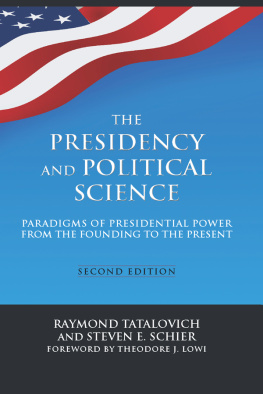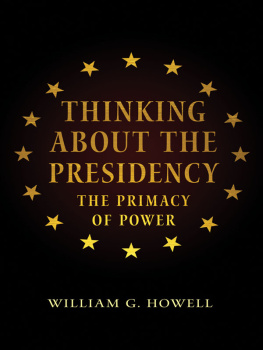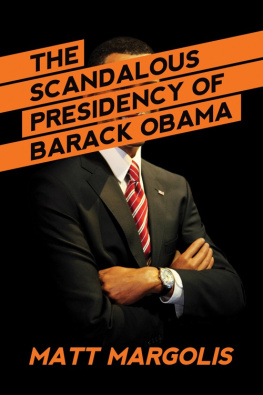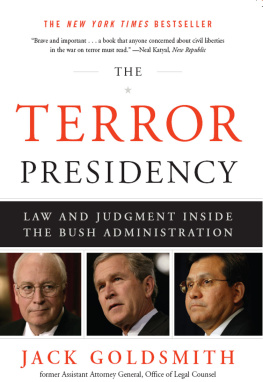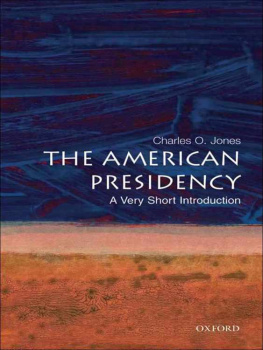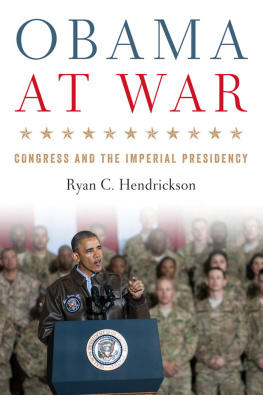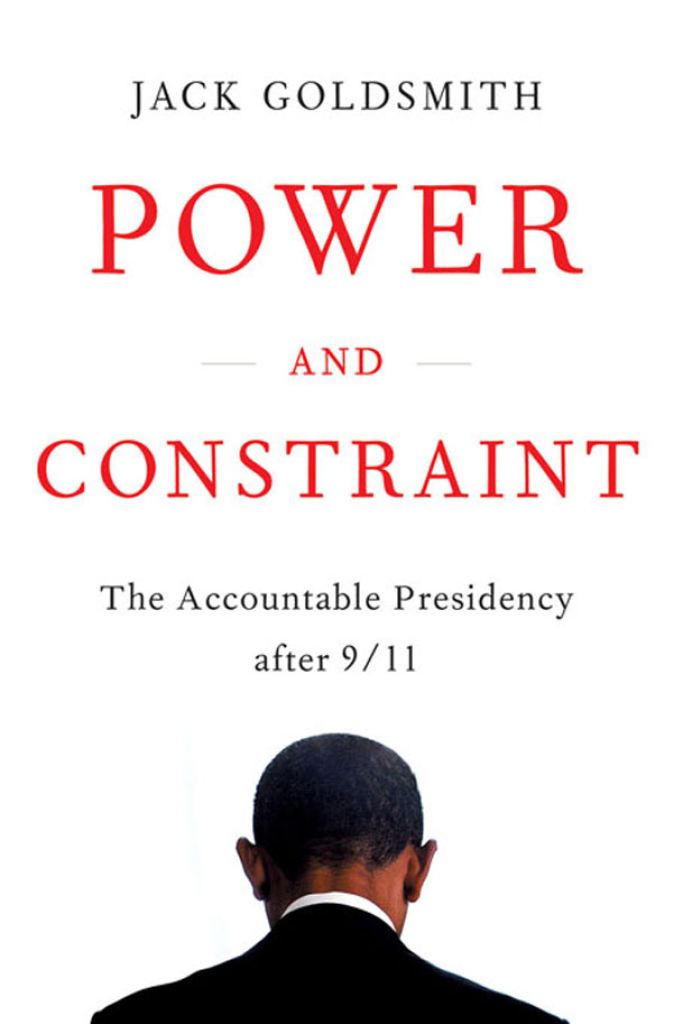
ALSO BY JACK GOLDSMITH
The Terror Presidency: Law and Judgment inside the Bush Administration Who Controls the Internet? Illusions of a Borderless World (with Tim Wu) The Limits of International Law (with Eric A. Posner)
POWER
AND
CONSTRAINT
The Accountable Presidency after 9/11
JACK GOLDSMITH

W. W. NORTON & COMPANY
New York London
To Mom with love
CONTENTS
Introduction
CHECKS AND BALANCES IN AN ENDLESS WAR
ITS GOING TO TAKE a long time to win this war, President George W. Bush told a group of Pentagon employees on September 17, 2001, six days after the terrorist attacks that marked a new era in global history. Bush was right. More than a decade after 9/11, Osama Bin Laden is dead and many of his top associates have been killed or captured. And yet the endless war against Islamist terroristsalready the longest war in American historycontinues on several fronts, in several countries, with no end in sight.
An endless war, and an endless emergency too. A national emergency exists by reason of the terrorist attacks at the World Trade Center, New York, New York, and the Pentagon, and the continuing and immediate threat of further attacks on the United States, Bush declared, three days after 9/11.
War and emergency invariably shift power to the presidency. Permanent war and permanent emergency threaten to make the shift permanent. George W. Bushs counterterrorism initiativeswarrantless surveillance, targeted killings, detention without trial, military commissions, limitations on habeas corpus, aggressive interrogations, and much morewere unthinkable on September 10, 2001. Bush succeeded in preventing another attack on the homeland, an accomplishment he described as the most meaningful of his presidency.
Barack Obama campaigned against the Bush approach to counterterrorism and came to office promising to repudiate it and to restore the rule of law. As for our common defense, we reject as false the choice between our safety and our ideals, he said in his inaugural address.
Spector and Zelizera mainstream politician and a progressive professorreflect the widely held view that 9/11 was the death knell for the separation of powers and for presidential accountability. For many, James Madisons famous concern that no nation could preserve its freedom in the midst of continual warfare has been realized.
The problem with the conventional wisdom about the expansion of presidential power is that it tells only half the story. The rest of the story, the one I tell in this book, is a remarkable and unnoticed revolution in wartime presidential accountability that checked and legitimated this growth in presidential power.
The U.S. Constitution creates a system of checks and balances that gives other institutionsCongress, the courts, and the pressthe motives and tools to counteract the President when they think he is too powerful, pursues the wrong policies, or acts illegally. Far from rolling over after 9/11, these institutions pushed back far harder against the Commander in Chief than in any other war in American history. The post-9/11 Congress often seemed feckless, especially in its oversight responsibilities. But it nonetheless managed to alter and regulate presidential tactics on issuesinterrogation, detention, surveillance, military commissions, and morethat in previous wars were controlled by the President. Congress was often spurred to action because the American press uncovered and published the executive branchs deepest secrets. It was also moved by federal judges who discarded their traditional reluctance to review presidential military decisions and threw themselves into questioning, invalidating, and supervising a variety of these decisionsdecisions that in other wars had been the Presidents to make. Judicial review of the Commander in Chie f s actions often left him without legal authority to act, forcing him to work with Congress to fill the legal void.
These traditional forces received crucial support from something new and remarkable: giant distributed networks of lawyers, investigators, and auditors, both inside and outside the executive branch, that rendered U.S. fighting forces and intelligence services more transparent than ever, and that enforced legal and political constraints, small and large, against them.
On the inside, military and national security lawyers devoted their days and many of their nights to ensuring that the Commander in Chief complied with thousands of laws and regulations, and to responding to hundreds of lawsuits challenging presidential wartime action. These lawyers checks were complemented by independent executive-branch watchdogs, such as inspectors general and ethics monitors, who engaged in accountability-enhancing investigations of the Presidents military and intelligence activities. These actors were empowered by a culture of independence that had grown up quietly in the previous three decades. And they enforced laws traceable to 1970s congressional reforms of the presidency that most observers assumed were dead but that turned out to be alive and quite fearsome.
On the outside, nongovernmental organizations like the American Civil Liberties Union and the Center for Constitutional Rights connected up with thousands of like-minded lawyers and activists in the United States and abroad. Together, these forcesoften, once again, invoking laws and institutions traceable to decades-old legal reformsswarmed the government with hundreds of critical reports and lawsuits that challenged every aspect of the Presidents war powers. They also brought thousands of critical minds to bear on the governments activities, resulting in best-selling books, reports, blog posts, and press tips that shaped the publics view of presidential action and informed congressional responses, lawsuits, and mainstream media reporting.
The pages that follow will show that these forces worked together in dynamic ways to uncover, challenge, change, and then effectively approve nearly every element of the Bush counterterrorism program. There are many reasons why Barack Obama continued so much of the Bush program as it stood in January 2009. But the most significant reason was that almost all of this program had been vetted, altered, and blessedwith restrictions and accountability strings attachedby the other branches of the U.S. government. Obama and his White House team, sobered by a terrorist threat they fully appreciated only once they assumed power, refused to walk away from widespread political and legal support for aggressive counterterrorism actions. The institutions that pushed back against the Bush presidency did not cease to exercise their influence during Obamas presidency. Obama too felt the sting of checks and balances when he tried and failed to close the Guantanamo Bay detention facility and to prosecute 9/11 mastermind Khalid Sheikh Mohammed in civilian court.
Some of these checks on the presidency since 9/11 have occurred behind the scenes, but most of them have taken place in plain sight. And yet as a nation we have missed them, and their significance. We missed them because many came from distributed forces rather than from the institution traditionally conceived as the main check on the President during war, Congress. And we missed them because George W. Bush was seen as such a polarizing figure in a scary and unfathomable war, a perception ingrained by Barack Obamas rhetorically powerful campaign criticisms. When President Obama largely followed his predecessors course, almost everyone assumed that the best explanation was that the presidency as an institution was out of control. In this book I sketch a different, and I believe more persuasive, explanation for the congruence. Two presidential administrations with starkly different views about executive power and proper counterterrorism tactics ended up in approximately the same place because forces more powerful than the aims and inclinations of the presidents and their aides were at work.
Next page

